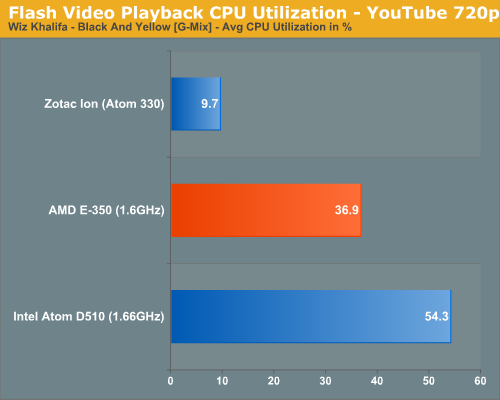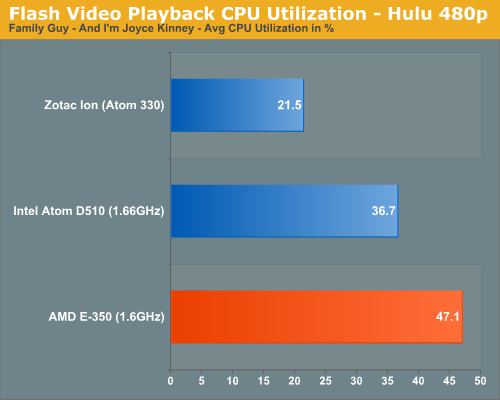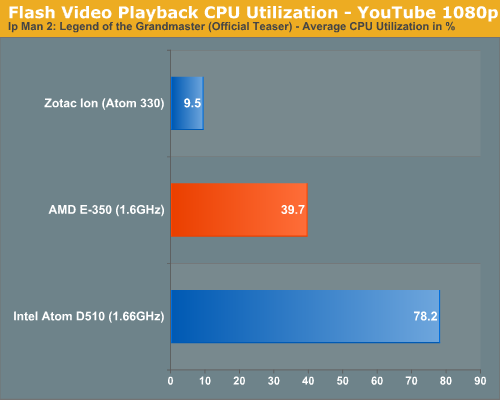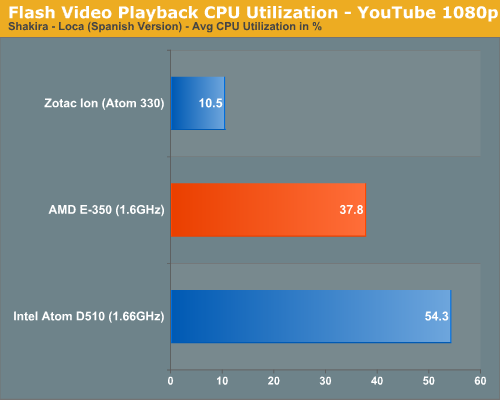The Brazos Review: AMD's E-350 Supplants ION for mini-ITX
by Anand Lal Shimpi on January 27, 2011 6:08 PM ESTBlu-ray & Flash Video Acceleration
Compatibility is obviously a strongpoint of Brazos. So long as what you’re decoding can be hardware accelerated you’re pretty much in the clear. But what about CPU utilization while playing back these hardware accelerated formats? The CPU still needs to feed data to the GPU, how many cycles are used in the process?
I fired up a few H.264/x264 tests to kick off the investigation. First we have a 1080p H.264 Blu-ray rip of Quantum of Solace, averaging around 15Mbps:
| Quantum of Solace 1080p H.264 CPU Utilization (1:00 - 1:30) | |||||
| Platform | Min | Avg | Max | ||
| AMD E-350 | 22.7% | 27.8% | 35.3% | ||
| Intel Atom D510 | Fail | ||||
| Zotac ION | 14.6% | 17.2% | 20.1% | ||
A standard Atom platform can’t decode the video but ION manages a 17% average CPU utilization with an Atom 330. Remember that the Atom 330 is a dual-core CPU with SMT (4-threads total) so you’re actually getting 17.2% of four hardware threads used, but 34.4% of two cores. The E-350 by comparison leaves 27.8% of its two cores in use during this test. Both systems have more than enough horsepower left over to do other things.
Next up is an actual Blu-ray disc (Casino Royale) but stripped of its DRM using AnyDVD HD and played back from a folder on the SSD:
| Casino Royale BD (no DRM) CPU Utilization (49:00 - 49:30) | |||||
| Platform | Min | Avg | Max | ||
| AMD E-350 | 28.1% | 33.0% | 38.4% | ||
| Intel Atom D510 | Fail | ||||
| Zotac ION | 17.7% | 22.5% | 27.5% | ||
Average CPU utilization here for the E-350 was 33% of two cores.
Finally I ran a full blown Blu-ray disc (Star Trek) bitstreaming TrueHD on the E-350 to give you an idea of what worst case scenario CPU utilization would be like on Brazos:
| Star Trek BD CPU Utilization (2:30 - 3:30) | |||||
| Platform | Min | Avg | Max | ||
| AMD E-350 | 29.0% | 40.1% | 57.1% | ||
At 40% CPU utilization on average there’s enough headroom to do something else while watching a high bitrate 1080p movie on Brazos. The GPU based video decode acceleration does work, however the limits here are clear. Brazos isn’t going to fare well as a platform you use for heavy multitasking while decoding video, even if the video decode is hardware accelerated. As a value/entry-level platform I doubt this needs much more explanation.
Now let’s talk about Flash.
I ran through a number of Flash video tests at both YouTube and Hulu ranging in resolution from 480p all the way up to 1080p. I used Flash 10.1, 10.2 beta as well as an unreleased version of 10.2 beta provided by AMD.


For the most part GPU accelerated Flash video does work well. Performance under both YouTube and Hulu was flawless, provided that I wasn’t watching 1080p content. Watching 1080p content in YouTube wasn’t entirely smooth on Brazos, despite posting very reasonable CPU utilization numbers.


I took my concerns to AMD and was told that this was a known issue with Brazos and Flash 10.1 and that 10.2 should alleviate the issue. AMD then supplied me with an unreleased version of Flash 10.2 to allow me to verify its claims. While 1080p playback improved with AMD’s 10.2 beta, it wasn’t perfect (although it was very close). AMD wouldn’t tell me the cause of the problem but it’s currently working on it with Adobe. At the end of the day I don’t believe it’s a dealbreaker, but early Brazos adapters should expect some stuttering when playing back 1080p YouTube videos. Note that 720p and lower resolution videos were perfectly smooth on Brazos.










176 Comments
View All Comments
flyck - Friday, January 28, 2011 - link
at idle the SB cpu uses 30% more power (or 4W) (2400S), during playback the difference between the cpu will also be around 1W.the chip consumption is however not known.
duploxxx - Friday, January 28, 2011 - link
Nice review, always a good review from Anandtech, thxFor now brazos could use only another cpu speedbump to totally destroy all atom based solutions and even more get into the ULV regions. A wider APU platform offer (different clockspeeds) would be better though.
To crush next gen Atom I think AMD knows what to do, update like 69xx series on uarch for gpu, add higher speed or more core in the new 28nm package all combined with turbo modes by the end of this year and Intel will never have a chance unless they bring a new uarch.
bjacobson - Saturday, January 29, 2011 - link
meh, they can just compete with the ULV Pentiums.To me that's what Brazos is competing with performance wise-- of course it stomps Atom...so what's next? ULV chips...and it has a much harder time with them.
beginner99 - Friday, January 28, 2011 - link
...as mentioned before I do not see the benefit of playing MW 2 at 20 fps on a 1024x768 resolution. Who will do that? probably no one because it is still unplayable.I mean this thing is nice and better than Atom (assuming same price) but I think the GPU is a waste of die space. Why not beef up the decode engine? I mean this thing will be used mainly for media stuff and not for gaming. I mean not being able to play 1080p youtube perfectly is already fail for a nettop/htpc because that is a very, very likely usage scenario (1080p tv or screen).
More fixed function hardware fro media would be better maybe even something like QuickSync so you could actually trans-code on your htpc. Or said otherwise functionality you get with these broadcom cards, which quite a few atom system have.
I would still 100% choose this over Atom.
nitrousoxide - Friday, January 28, 2011 - link
Then it won't be an APU :)And AMD doesn't have smaller GPU...HD5400 Cedar is the smallest available design AMD has lol
While it can't run Modern Wardare 2, I'm quite satisfied with the fact that it can run L4D2, Warcraft 3, Starcraft 2 and I can even play Command and Conquer Red Alert 3 tuned to "medium".
sebanab - Monday, January 31, 2011 - link
I also think the 3D functions of the chip might as well not be there at all.But they should come in handy for Aero effects in Win7 and why not , Win8.
Shadowmaster625 - Monday, January 31, 2011 - link
1080p youtube is just too slow to be practical for anything other than watching trailers for the really big movies that come once a year, like Avatar. Most people's internet connections simply cannot keep up to stream realtime 1080p. And even if you did have the bandwidth, that dont mean that youtube is going to have it.720p is much more reasonable, though even then comcast 20mbps + youtube have trouble keeping that pipe filled most of the time. Most of the time I go with 480p just because less wait is more important than the added quality.
krumme - Friday, January 28, 2011 - link
I like the review, epecially the new HD bm and the recommandations. Looking at the hd bm themselves one had to wonder if 7200rpm was not enough for the bobcat? but i guess there is room for personal interpretation. I think Anand really likes his ssd more than i do :)I still feel the emphasis on multithreaded and heavy workloads is a little to much, and the same for the emphasis on the gaming side. But ofcourse there must be some readers that will use this for for gaming.
I hope AMD get this bobcat on lower leaking gf 32nm process, so we can have even better battery life.
bjacobson - Saturday, January 29, 2011 - link
You know I've found my 160GB 5400RPM drive to be plenty fast for my Atom. I doubt a 7200RPM would be too terribly much of a bottleneck. Might impact battery life though compared with SSD on a laptop.I found the multi-threading very useful-- it showed us that even in perfect-scalable applications (Cinebench), the e350 still stomps a dual core dual threaded Atom. That's the conclusive evidence I was looking for that this is a better chip.
macs - Friday, January 28, 2011 - link
My thought:- AMD E-350 itx board: 100-130 $
- Intel Sandy Bridge Pentium G620T (rumored release date 2/27/11, dual core, 35w TDP) 70$ paired with a H67 ITX board like the Foxconn one (75$) TOT:145$
I suspect that we will have similar power cosumption (probably Idle is even better for Intel) but the performance are way better in Sandy Bridge and totally worth the 10/50$ price difference.
Am I wrong? (sorry for my poor English)